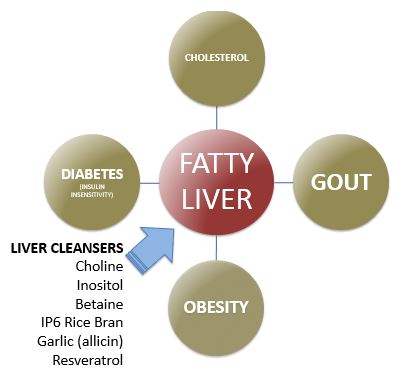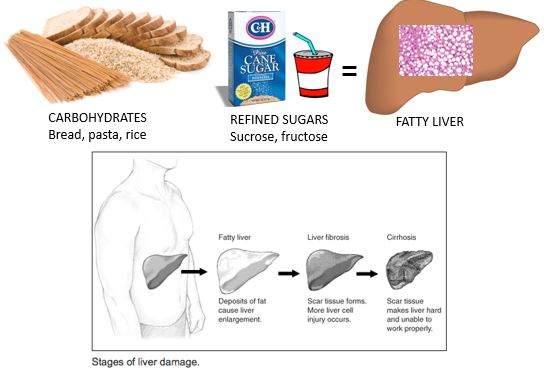Posted March 6, 2015: by Bill Sardi
After decades of misdirection, elevated levels of circulating cholesterol are no longer considered a significant cause of coronary artery disease though there are many cardiologists who are not ready to concede that point. [Applied Physiology Nutrition Metabolism Dec 2014] A recent study of 7000 subjects published in the European Heart Journal did not find that cholesterol is a risk factor for heart disease. [European Heart Journal Sept 1, 2014]
If elevated cholesterol is not a marker for arterial narrowing, then what is it a marker of?
Over eight decades ago researchers discovered why circulating cholesterol levels rise with advancing age. It was from fatty liver disease, a modern plague that now affects up to a third of North Americans. The prevalence of non-alcoholic fatty liver disease ranges from 27-34% in the USA and 40-90% of the obese population worldwide. [British Journal Nutrition Dec 14, 2014]
This is largely due to the rising consumption of refined sugar, in particular high fructose corn syrup, and carbohydrates (bread, rice, pasta) which turns to fat and cholesterol.
It has long been known that chronic alcohol consumption can induce a fatty liver condition. In 1949 it was demonstrated in the animal laboratory that mice fed sugar had a considerable greater amount of fat stored in their liver and accompanying scarring (fibrosis) than mice given alcohol. [British Medical Journal Nov 5, 1949]
Fatty liver was a rarity decades ago. But now that so much refined sugar and carbohydrates (bread, pasta and rice) are consumed, 35% of Americans have a fatty liver condition that is not related to over-consumption of alcohol.
I assert that what physicians have been treating with cholesterol-lowering drugs over recent decades is only indirectly arterial disease and more directly liver disease. And while statin cholesterol-lowering drugs are widely used to treat fatty liver disease, they are not particularly effective and they are a liver toxin. [Medical Science Monitoring Dec 2009] Some statin drugs actually increase deposition of fat in the liver. [Journal Physiology Pharmacology June 2013]
When it comes to the modern diabesity epidemic, all roads lead to fatty liver disease, not cholesterol per se, though elevated levels of cholesterol emanate from fatty liver disease, not the other way around as mistakenly believed.
Examine the evidence below linking obesity, diabetes, gout and cardiovascular disease with fatty liver.
We have to go back six decades to when Dr. Samuel Zelman published his first study that connected fatty liver to obesity. That was in 1952.
Dr. Zelman observed fatty liver in a hospital worker who drank 20 Coca-Colas a day which provided an obscene amount of sugar —1600 milligrams per day, equivalent to drinking a pint of whiskey per day. So he set out to study this problem.
Dr. Zelman had a difficult time finding obese adults who were not alcoholics. That was the era prior to high fructose corn syrup being added to foods and other refined sugars being so prevalent in the diet today. Soft drink companies didn’t begin sweetening soda pop with high fructose corn syrup until the early 1980s. There is a growing body of evidence implicating high fructose corn syrup in processed foods and beverages with fatty liver disease. [Hepatology June 2009]
It took Dr. Zelman a year and a half to find 20 obese subjects who were not alcoholics. All of his obese subjects had some degree of fatty liver. All of Dr. Zelman’s study patients preferred carbohydrates (bread, pasta, rice) over protein in their diet. [AMA Archives Internal Medicine Aug 1952.
The fatty liver disease epidemic slowly grew. Prior to 1980 fatty liver disease was rarely diagnosed. In 1980 Mayo Clinic doctors reported on 20 patients with non-alcoholic fatty liver disease, 90% whom were obese, 35% had heart disease, 30% had gall bladder problem and 25% had adult-onset diabetes. The Mayo Clinic doctors coined the term “nonalcoholic steatohepatitis” (abbreviated NASH). [Mayo Clinic Proceedings July 1980]
Body mass index (BMI) is greater among individuals with fatty liver. [Serbian Archives of Entire Medicine March-April 2008]
Physicians are advised to use BMI as an early indicator of fatty liver. Subjects with a BMI of greater than 27 are about three times more likely to have fatty liver. [Journal Gastroenterology April 2013; Journal Gastroenterology March 2013] See comment in PubMed Commons below
In a study population of 54,325 the risk for fatty liver was 11.3% but rises to 23.1% among those individuals with gout. [Scandinavian Journal Rheumatology Nov 2010]
It is not surprising to learn that fatty liver disease increases the risk of cardiovascular disease three-fold in men, fourteen-fold in women, and seven-to-ten-fold in Type I diabetics. [World Journal Gastroenterology March 14, 2007; Journal Hepatology Oct 2010]
Patients with fatty liver may have a cardiovascular disease risk greater than posed by other risk factors. [Current Treatment Options Cardiovascular Medicine Aug 2009]
Examine the remarkable volume of published science showing choline, a common nutrient provided in eggs and other foods, is the antidote to what ails modern man.

Seven natural molecules that are reported to help control fatty deposits in the liver and blood circulation are choline, inositol, betaine, methionine, rice bran IP6, garlic (allicin) and resveratrol. [Biochemistry Journal April 1951; Anticancer Research 1999; Lipids Health & Disease 2010; World Journal Hepatology April 2014] All are widely available as dietary supplements.
Choline is a superior liver cleansing agent. Choline is at least 4 times better than inositol and 3 times better than betaine or methionine in that regard. [Journal Biological Chemistry Sept 1950]
Greater circulating betaine but not choline is associated with better
body composition (-4.9% less weight; -4.7% body mass index; -2.5% waist circumference). [International Journal Obesity Aug 25, 2014]
The dietary intake level of choline varies by 3-fold and there are many humans, particularly females with a specific gene mutation who have an increased demand for choline. [Current Opinion Clinical Nutrition Metabolic Care May 2013]
The demand for choline increases among women whose estrogen production is in decline. [Current Opinion Gastroenterology March 2012] That is precisely when women experience a rise in circulating cholesterol.
Another study was conducted to determine whether a rise in circulating cholesterol in women is due to chronological (calendar) aging or to menopause. It was determined that women experience a unique increase in cholesterol at the time of final menstrual period compared to males. [Journal American College Cardiology Dec 15, 2009] Postmenopausal females have been found to have the worst scarring (fibrosis) of the livers. [American Journal Clinical Nutrition April 2012]
Choline is abundant in a variety of foods. Egg yolks are a particularly concentrated source of choline. [US Department Agriculture] Many high-choline foods are rich in fats and cholesterol and are being avoided by health conscious individuals. A list of choline-rich foods is provided by the US Department of Agriculture. [USDA]
Several population studies report that 25% of Americans eat diets very low in choline; less than 203 milligrams/day in the Framingham Heart Study; less than 217 mg/day in the Atherosclerosis Risk In Communities study and less than 293 mg/day in the Nurse’s Health Study; the Adequate Intake is 450–550 mg/day. [Current Opinion Gastroenterology March 2012]
Alarmingly, the bacteria in the human gut determine the availability of choline. Bacteria in the gut can convert choline to undesirable methylamines and mimic the effects of a choline-deficient diet and also promote the development of insulin resistance. [Proceedings National Academy Science Aug 15, 2006] Probiotics are posed as a remedy to this problem. [World Journal Gastroenterology Nov 28, 2014]
The PDR For Nutritional Supplements notes that lecithin (phosphatidylcholine) supplements provide choline but only provide 13% choline by weight (4230 mg lecithin provides 550 mg choline).
As already stated, eggs are a rich source of choline. That modern medicine shunned egg consumption makes one wonder if doctors were intentionally creating a recipe for more disease to treat.
Given all of the above information, it is not surprising to learn that foods consumed in an typical American breakfast (toast, pancakes, waffles, syrup, cereal, etc.) promote coronary artery disease but not eggs. [American Heart Journal Jan 2015]
Experts now say that “healthy populations experience no risk for developing coronary heart disease by increasing their intake of cholesterol… and have multiple benefits by the inclusion of eggs in their regular diet.” [Foods Function Nov 2010]

In animals it has been demonstrated that mega-dose niacin (beyond what most humans could possibly consume) can induce a fatty liver condition. It was determined this side effect was caused by shortage of choline induced by excessive niacin. [Journal Nutrition 1965]
It is common to find subjects with fatty liver are iron and copper overloaded. [World Journal Hepatology Feb 2015] Therefore it is not surprising to find metal-binding (chelating) molecules such as resveratrol (copper) and rice bran IP6 (iron, all heavy metals) are reported to be effective for fatty liver disease. Blood letting to reduce stored iron has also been found to be an effective measure against fatty liver disease. [World Journal Gastroenterology March 2014]
The consumption of iron-rich red meat is associated with increased risk for fatty liver disease. [Biomedical Environmental Science Aug 2012]
Since the 1930s it has been known that fatty liver disease, fomented by refined sugars and carbohydrate-rich diets, is central to the ongoing diabesity epidemic (diabetes, obesity, heart disease). One of the most renowned biologists, Charles Best, discovered that choline abolishes fatty liver disease and that discovery was thrown in the closet as the cholesterol theory of heart disease and the statin drug paradigm prevailed over the past four decades. Modern society has paid a terrible price for modern medicine’s proclivity to prefer prescription drugs over proven natural remedies. Both historical and modern science confirm choline, betaine, inositol and other available dietary supplements are undeniable antidotes to what ails modern man. ©2015 Bill Sardi, Knowledge of Health, Inc.
Posted in Diabetes, Dietary Supplements ; No Comments »
11
17
52
95
14
24
237
6
56
43
10
116
15
66
105